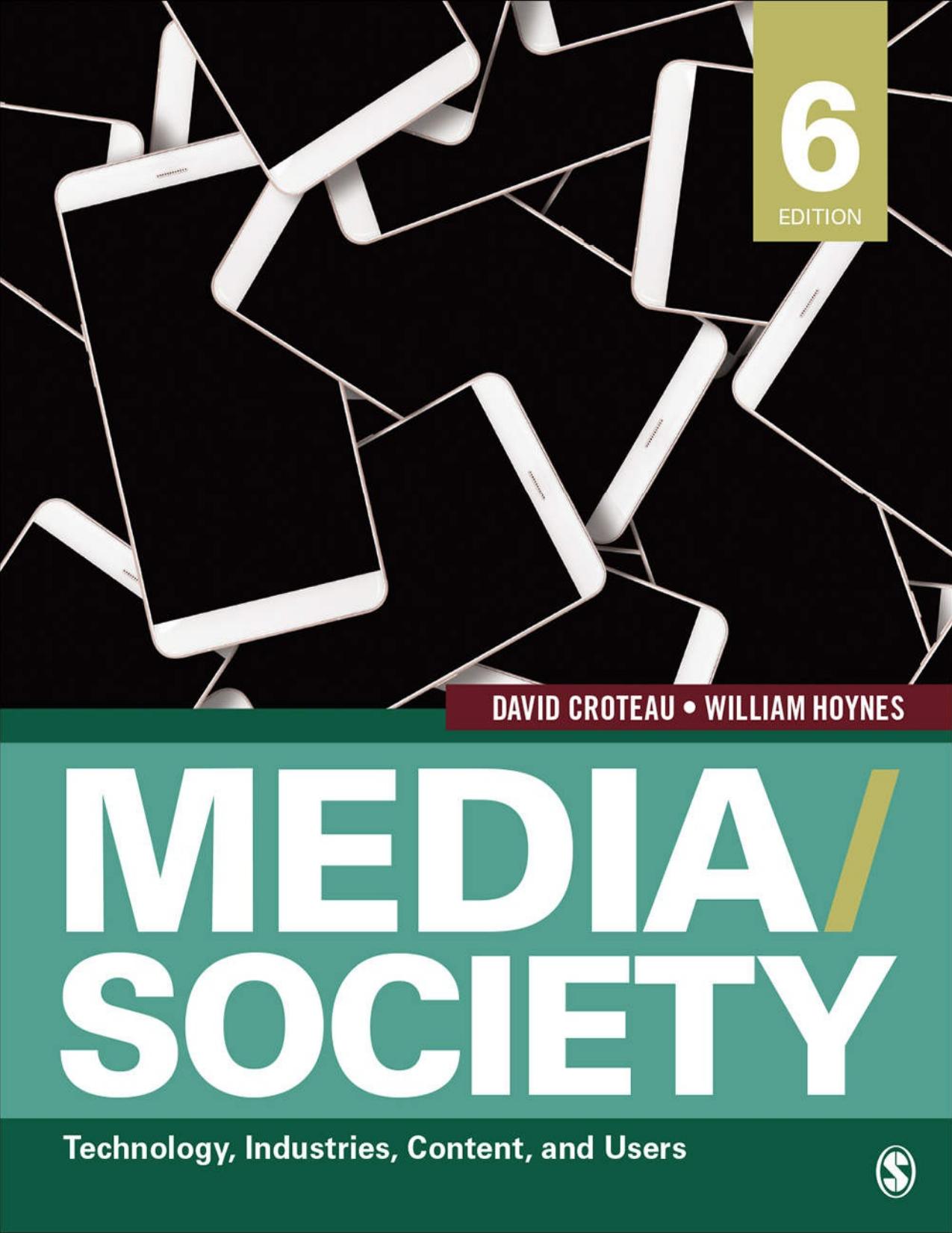Media Society Technology Industries Content and Users 6th Edition by David Croteau, William Hoynes ISBN 150631533X 9781506315331
$70.00 Original price was: $70.00.$35.00Current price is: $35.00.
Instant download Media Society Technology Industries Content and Users 6th Edition after payment
Media Society Technology Industries Content and Users 6th Edition by David R. Croteau, William Hoynes – Ebook PDF Instant Download/Delivery: 150631533X, 9781506315331
Full dowload Media Society Technology Industries Content and Users 6th Edition after payment

Product details:
ISBN 10: 150631533X
ISBN 13: 9781506315331
Author: David R. Croteau, William Hoynes
Providing a framework for understanding the relationship between media and society, this updated Sixth Edition of Media/Society helps you develop the skills you need to critically evaluate both conventional wisdom and your own assumptions about the social role of the media. Authors David Croteau and William Hoynes retain the book’s basic sociological framework but now include additional discussions of new studies and up-to-date material on today’s rapidly changing media landscape. Now featuring streamlined content and a more engaging narrative, this edition offers expanded discussions of the “new media” world, including digitization, the internet, the spread of mobile media devices, the role of user-generated content, the potential social impact of new media on society, and new media’s effect on traditional media outlets
Media Society Technology Industries Content and Users 6th Table of contents:
PART I INTRODUCTION
Chapter 1 Media/Society in a Digital World
The Importance of Media
Models of Communication Media
Interpersonal and “Mass” Communication
Variable Boundaries and Active Users
Communication Today: A First Look
A Sociology of Media
The Sociological Perspective
Structural Constraint and Human Agency
Structure
Agency
Structure and Agency in the Media
Relationships between the Media and Other Social Institutions
Relationships within the Media Industry
Relationships between the Media and the Public
A Model of Media and the Social World
Applying the Model: Civil Rights in Two Media Eras
Mid-20th-Century Civil Rights Movement
Black Lives Matter
Conclusion
Discussion Questions
PART II TECHNOLOGY
Chapter 2 The Evolution of Media Technology
The History of Media Technology
Technological Determinism
Media’s Materiality
“Autonomous Technology” and “Technological Momentum”
Medium Theory
McLuhan’s Optimism
Postman’s Pessimism
Social Constructionism
From Print to Television
The Print Medium
The Telegraph
The Telephone
Sound Recording
Film and Video
Radio Broadcasting
Television
Television and Daily Life
Cable Television
The Internet
Creating the Internet
The Internet Grows Up
Some Characteristics of the Internet Era
Conclusion
Discussion Questions
PART III INDUSTRY
Chapter 3 The Economics of the Media Industry
Media Companies in the Internet Era
Products
Platforms
Pipes
Changing Patterns of Ownership
Concentration of Ownership
Products
Platforms
Pipes
Conglomeration and Integration
Strategy in a New Media Economy
The Power of Platforms: Facebook and Google as New Media Giants
Users
Media Content
Advertising and Paywalls
Telecommunications
Consequences of Conglomeration and Integration
Integration and Self-Promotion
The Impact of Conglomeration
The Effects of Concentration
Media Control and Political Power
Media Ownership and Content Diversity
Mass Media for Profit
Prime-Time Profits
Cheaper Programs for Smaller Audiences
Controlling Content and Distribution
Profit and the News Media
The Impact of Advertising
The Advertising–Content Connection
Advertising and the Press in the 19th Century
The British Press
The U.S. Press
Advertising and the Contemporary News Media
Conclusion
Discussion Questions
Chapter 4 Political Influence on Media
Media and Democracy
Free Speech to Free Markets: The Evolution of U.S. Regulatory Policy
Regulate or Deregulate?
The FCC’s Variable Role
Regulation in International Perspective
Regulation in Western Democracies
Regulation in Developing Nations
Competing Interests and the Regulation Debate
Industry Influence: Elections and Lobbying
Citizen Action: The Case of Low-Power Radio
Left and Right: Diversity versus Property Rights
Regulating Ownership
Media Outlets
Copyright and Intellectual Property
Regulating Content
Accuracy: Advertising
Diversity: The Fairness Doctrine
Morality: Obscene Materials
Self-Regulation: Censorship and Ratings
Movie Censorship and the Ratings System
Television Ratings
Music Parental Advisory Labels and Video Games
The “National Interest”: Military Censorship
Regulating Access and Distribution
Net Neutrality
The Concept of Net Neutrality
The Policy Battle
The Implications
Vertical Integration: Movies, TV, and Streaming
The Hollywood Studio System
Television’s Fin-Syn Regulations
Netflix and the Streaming Wars
Social Media Platforms
What Are Platforms?
Social Media Regulation
Self-Policing
Informal Political, Social, and Economic Pressure
Conclusion
Discussion Questions
Chapter 5 Media Organizations and Professionals
The Limits of Economic and Political Constraints
Working within Economic Constraints
Responding to Political Constraints
Decision Making for Profit: Imitation, Hits, and Stars
High Costs and Unpredictable Tastes
Art Imitating Art
Stars and the “Hit System”
Creating Hits and Producing Stars
Using Stars to Combat Uncertainty
Beyond Stars to a Universe of Products
The Organization of Media Work
Conventions
News Routines and Their Consequences
Technology and the New News Routines
Increased Economic Pressure
Expanded Volume and Diversified Sourcing
Increased Speed
Presentation and Engagement to Promote Traffic
Newsroom Automation
Objectivity
The Origins of Objectivity
Objectivity as Routine Practices and Their Political Consequences
Rejecting Objectivity: Alternative Journalism
Occupational Roles and Professional Socialization
Roles
Photography
Socialization of Photographers
Editorial Decision Making
The Work of the Book Editor
Scholarly Publishing
Norms on the Internet, New Media, and New Organizations
Conclusion
Discussion Questions
PART IV CONTENT: MEDIA REPRESENTATIONS OF THE SOCIAL WORLD
Chapter 6 Media and Ideology
What Is Ideology?
Ideology and the “Real” World
Dominant Ideology versus Cultural Contradictions
The “Culture War” Battles over Ideology
Ideology as Normalization
Theoretical Roots of Ideological Analysis
Early Marxist Origins
Hegemony
News Media and the Limits of Debate
Elites and Insiders
Economic News as Ideological Construct
Movies, the Military, and Masculinity
Action-Adventure Films
Vietnam Films and Recent War Films
Television, Popularity, and Ideology
Television and Reality
Television and the Changing American Family
Revising Tradition: The New Momism
Rap Music as Ideological Critique?
Advertising and Consumer Culture
Selling Consumerism in the Early 20th Century
Advertising and the Globalization of Culture
Internet Ideology
Conclusion
Discussion Questions
Chapter 7 Social Inequality and Media Representation
Comparing Media Content and the “Real” World
The Significance of Content
Content as Reflection of Producers
Content as Reflection of Audience Preference
Content as Reflection of Society in General
Content as an Influence on Audiences
Content as Self-Enclosed Text
Race, Ethnicity, and Media Content: Inclusion, Roles, and Control
Racial and Ethnic Diversity in Media Content
Film
Television
Advertising
Video Games
Growing Diversity and Abundance amid Audience Fragmentation
Race, Ethnicity, and Media Roles
Early Images of Race
Slow Change and “Modern” Racism
Race and Class
Controlling Media Images of Race
Gender and Media Content
Women: Presence and Control in the Media
Changing Media Roles for Women . . . and Men
The Case of Women’s Sports
Class and the Media
Class and Media Content
Family-Based Situation Comedies
Tabloid Talk Shows and Reality Television
The Union Taboo
News Media
Advertising
Explaining Class Images: “Some People Are More Valuable Than Others”
Sexual Orientation: Out of the Closet and into the Media
Conclusion
Discussion Questions
PART V USERS
Chapter 8 Audiences and Creators
The Active Audience: Balancing Agency and Structure
Polysemy: Media’s Multiple Meanings
Interpretive Constraint: Encoding/Decoding and Social Structure
Decoding Meanings and Social Position
Class and Nationwide News
Gender, Class, and Television
Race, News, and Meaning Making
Resistance and Feminist Identity
International Readings of Literature
Making Meaning Online: Second Screens
Social Position Online: Black Twitter
The Social Context of Media Use
The Pleasures of Media: Celebrity Games
Romance Novels and the Act of Reading
Watching Television with the Family
The Limits of Interpretation
Interpretive Resistance and Feminist Politics
Culture Jamming
Content Creation and Distribution
Participatory Culture
Participation Online
Who Are the Content Creators?
Why Create?
Media Fans
Users as Gatekeepers and Distributors
Conclusion
Discussion Questions
Chapter 9 Media Influence
Learning from Media Effects Research
Early Works: Establishing the Agenda
The Press and Democracy
Entertainment and Children
Mass Society and Media Influence
Mitigating Media Effects
Limited Effects and the Two-Step Flow of Influence
Active Audiences
Highlighting Media Influence
Agenda Setting and Framing
Framing: Second-Level Agenda Setting
New Agenda-Setting Players in the Internet Era
The Spiral of Silence
Learning from Media
Cultivation Theory
Mediatization
The Concept of Mediatization
The Mediatization of Society and Media Logic
The Mediatization of Politics
The Politics of Image
Political Actors
Setting the Stage
The Decline of Political Parties
Communication Professionals and “Post-Truth” Politics
Working with the News Media
Using the Internet
Social Movements
Citizen Alienation
The Internet’s Uncertain Political Future
Digital Dilemmas: Online Media Influence
Social Media Logic and Algorithmic Power
The Crisis in Journalism
Information Distortions: Misinformation and Echo Chambers
Computational Propaganda: Trolls and Twitter Bots
Hate and Censorship
Managing Our Social Selves
Conclusion
Discussion Questions
PART VI AFTERWORD
Chapter 10 Globalization and the Future of Media
What Is Globalization?
Crossing Limits of Time and Space
Crossing Cultural Boundaries
The Promise and Reality of Media Globalization
The Global Media Industry
Global Products, Centralized Ownership
Traditional Media: Disney Worldwide
The New Global Media Giants: Google and Facebook
Interpreting Global Media Content
People also search for Media Society Technology Industries Content and Users 6th:
what industry is media
what is creative media industries
what industry is social media in
examples of media industry
media/society technology industries content and users


